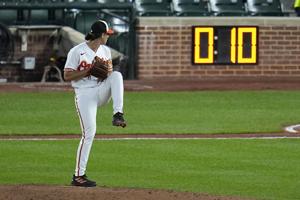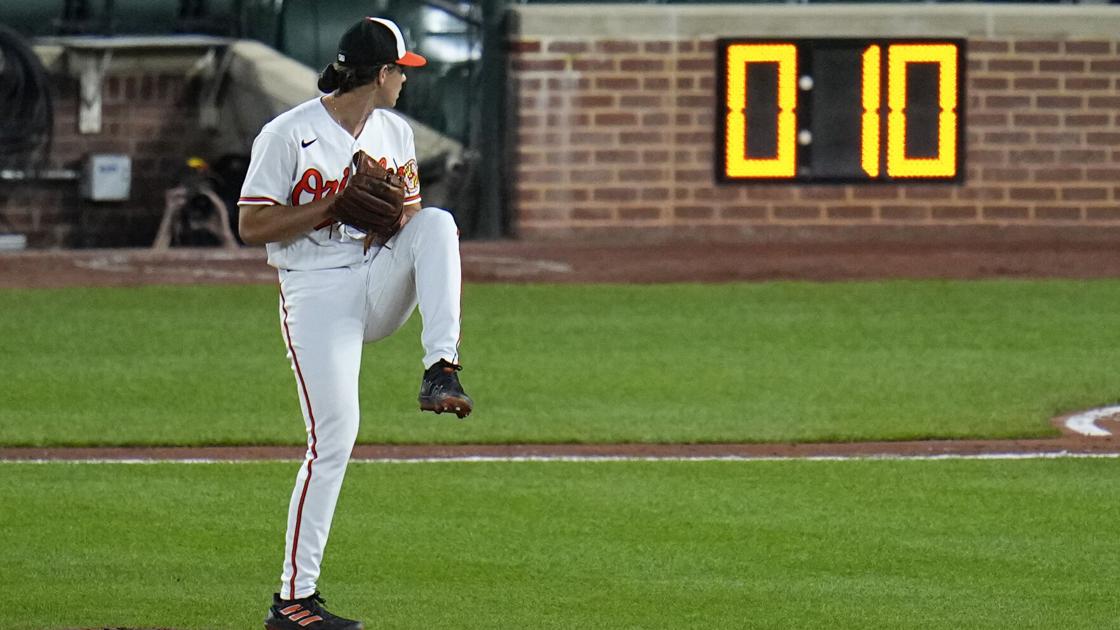MLB’s new pitch clock may be leading to more blown saves

NEW YORK — The pitch clock has sped up baseball as hoped — and it might be leading to more exciting endings, too.
A quarter of the way through Major League Baseball’s first season with the pitch timer, relief pitchers seem to be bearing the most stress from it, with save conversions dropping to 61.4% from 67.8% at a similar point last season.
The save percentage is near the bottom range of the past decade, which averaged 65.1%, MLB said Monday. The high was 70% in 2015 and the low 61% in the pandemic-shortened 2020 season.
“Whenever relievers are coming in, it’s mostly a stressful situation,” said Toronto Blue Jays closer Jordan Romano, whose time between pitches dropped from to 14.8 seconds from 20.5 last season. “It was nice before when you did have those extra few seconds.
“Now you’ve just got to get your thoughts together and go,” the 2022 All-Star added. “I haven’t noticed it too much but yeah, I guess in the times I’ve struggled, a couple extra seconds would have been nice.”
People are also reading…
The average time of nine-inning games fell to 2 hours, 37 minutes from 3:05. That is on track to be the fastest since 1984 and would result in an everyday player being on the field about 80 fewer hours this season.
Batting average is up 14 percentage points for left-handed hitters and nine percentage points overall. Scoring has increased 8% and stolen bases are up 40%. The clock has caused an average of 0.72 violations per game.
Just over a quarter of the season had been played through Sunday, 610 of 2,430 scheduled games. There had been 307 saves in 500 save chances — a 10-year-high in opportunities.
Pitchers have 15 seconds to deliver a pitch with the bases empty and 20 seconds with runners on base, with a limit of two disengagements from the rubber per plate appearance.
“I think back-end relievers, guys that have closed in the past, I think that’s been the biggest adjustment for them, just because they can’t reset,” Baltimore manager Brandon Hyde said. “There’s so much adrenaline, the moment’s so big at that point.”
Starters have been impacted, too. Lucas Giolito of the Chicago White Sox has cut his time between pitches to 16.4 seconds from 20.7.
“It’s been useful for just like developing rhythm, not letting myself think too much and take too much time,” he said. “It’s like you’ve got to get the ball back and get it going and fire it. You can’t be overthinking.”
Other rules added for this season also seem to be having intended results, including a limit on infield shifts that requires two infielders on either side of second base and within the outer boundary of the infield, as well as an increase in the size of bases to 18-inch squares from 15-by-15.
The big league batting average of .247 was up from .236 at this point last season, when final average was .243. Offense usually increases in warmer summer months, and last year’s first month was plagued by unusually cold and wet weather in a significant number of cities.
Left-handed batting average is up 14 points to .245, and there are more runs per game (9.1 from 8.4) and stolen bases per game (1.4 from 1.0).
The stolen base success rate of 78.4% was the highest on record, up from 74.1% at a similar point last year.
“Pace of play, pro. Dislike everything that leads to more stolen bases, hate that,” said Cleveland pitcher Shane Bieber, the 2020 AL Cy Young Award winner. “For myself, obviously, but for catchers, as well, it sucks. People look at the stolen base rate and go directly to catchers, but there’s so much more that goes into it.”
Of 437 timer violations, 287 were called on pitchers (65.7%), 126 on batters (28.8%) and five on catchers (1.1%).
San Diego’s Joe Musgrove leads pitchers with five violations, followed by Cincinnati’s Hunter Greene with four. Among batters, Boston’s Yu Chang, San Francisco’s J.D. Davis, Atlanta’s Eddie Rosario and Pittsburgh’s Carlos Santana are tied for the high of three apiece.
For all the latest Sports News Click Here
For the latest news and updates, follow us on Google News.

